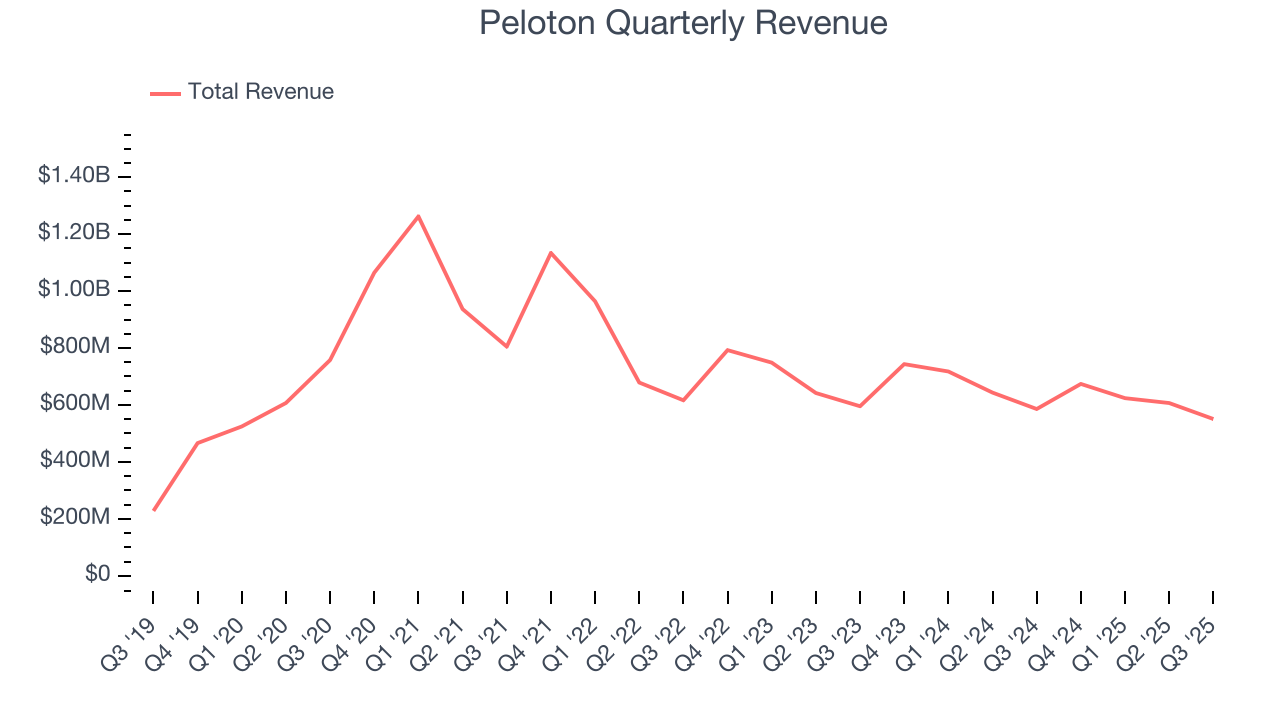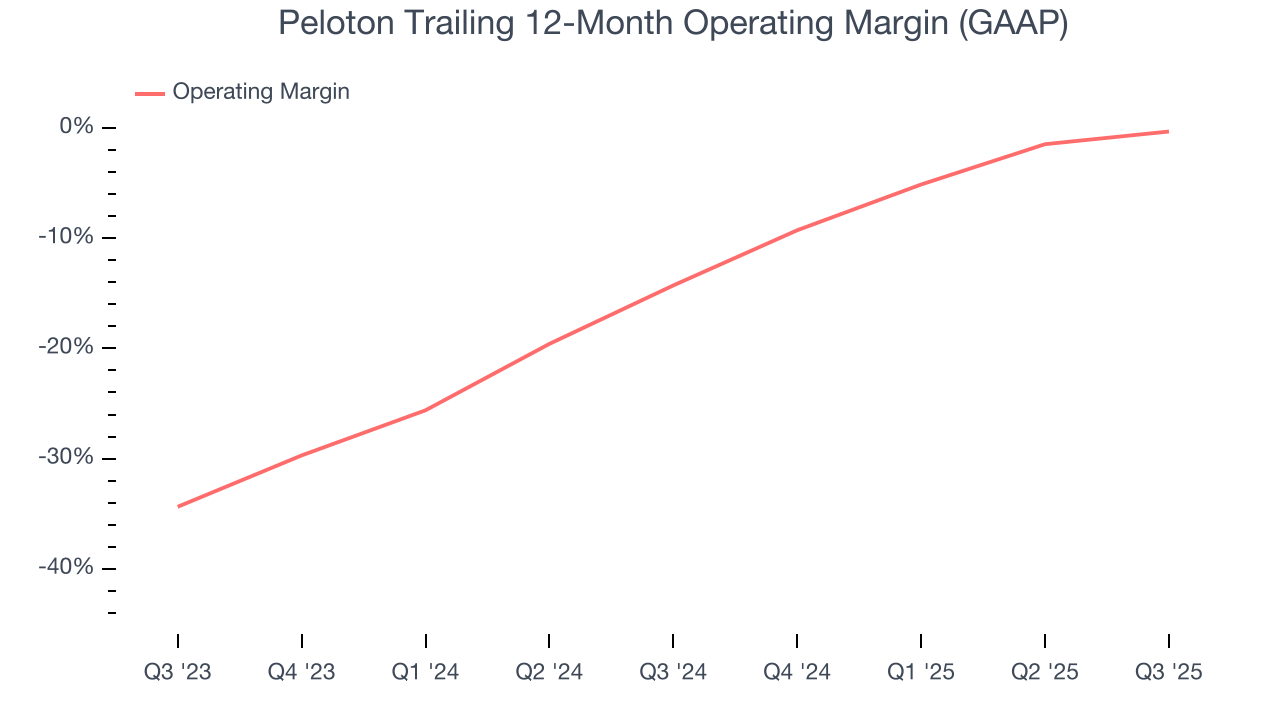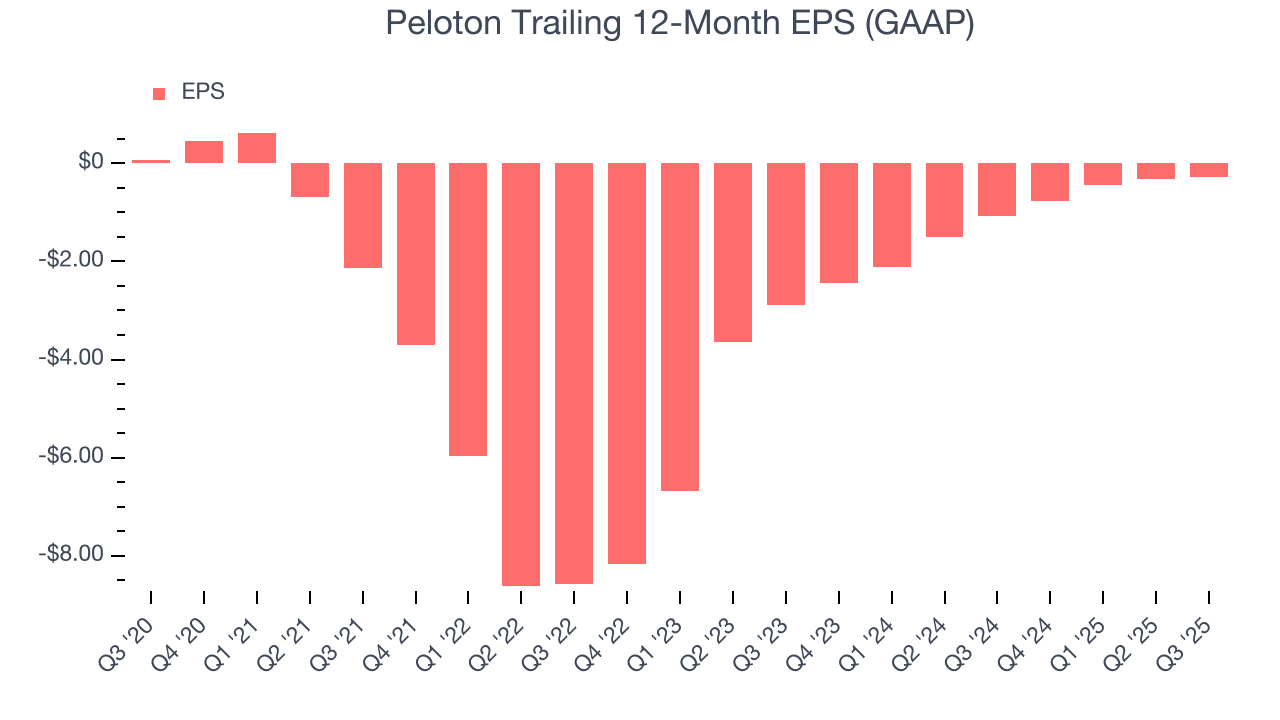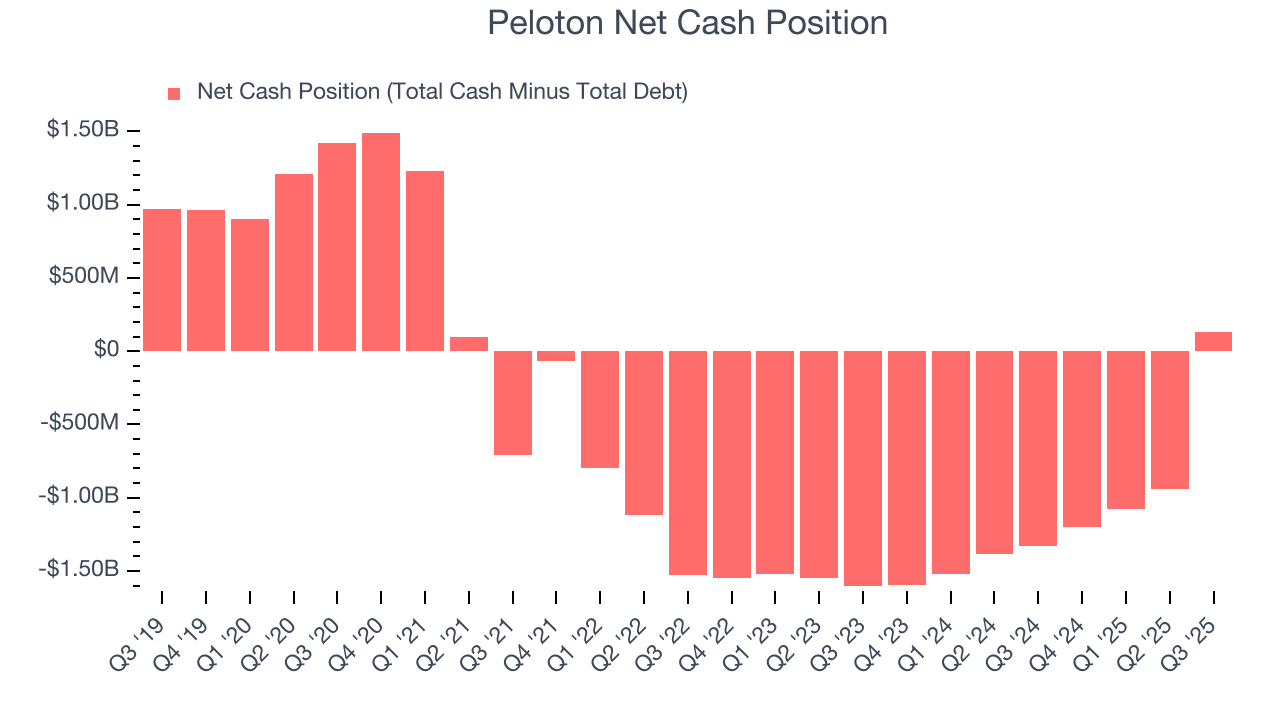
Peloton (PTON)
Peloton is up against the odds. Not only did its demand evaporate but also its negative returns on capital show it destroyed shareholder value.― StockStory Analyst Team
1. News
2. Summary
Why We Think Peloton Will Underperform
Started as a Kickstarter campaign, Peloton (NASDAQ: PTON) is a fitness technology company known for its at-home exercise equipment and interactive online workout classes.
- Sales stagnated over the last five years and signal the need for new growth strategies
- Performance over the past five years shows each sale was less profitable, as its earnings per share fell by 16.5% annually
- Historical operating margin losses point to an inefficient cost structure


Peloton falls short of our quality standards. There are more appealing investments to be made.
Why There Are Better Opportunities Than Peloton
Why There Are Better Opportunities Than Peloton
Peloton is trading at $6.57 per share, or 35.1x forward P/E. Not only is Peloton’s multiple richer than most consumer discretionary peers, but it’s also expensive for its revenue characteristics.
There are stocks out there similarly priced with better business quality. We prefer owning these.
3. Peloton (PTON) Research Report: Q3 CY2025 Update
Exercise equipment company Peloton (NASDAQ:PTON) announced better-than-expected revenue in Q3 CY2025, but sales fell by 6% year on year to $550.8 million. Guidance for next quarter’s revenue was optimistic at $675 million at the midpoint, 2.2% above analysts’ estimates. Its GAAP profit of $0.03 per share was $0.03 above analysts’ consensus estimates.
Peloton (PTON) Q3 CY2025 Highlights:
- Revenue: $550.8 million vs analyst estimates of $539.6 million (6% year-on-year decline, 2.1% beat)
- EPS (GAAP): $0.03 vs analyst estimates of $0 ($0.03 beat)
- Adjusted EBITDA: $118.3 million vs analyst estimates of $97.38 million (21.5% margin, 21.5% beat)
- The company reconfirmed its revenue guidance for the full year of $2.45 billion at the midpoint
- EBITDA guidance for the full year is $450 million at the midpoint, above analyst estimates of $438.9 million
- Operating Margin: 7.5%, up from 2.1% in the same quarter last year
- Free Cash Flow Margin: 12.2%, up from 1.8% in the same quarter last year
- Connected Fitness Subscribers: 2.73 million, down 168,000 year on year
- Market Capitalization: $2.91 billion
Company Overview
Started as a Kickstarter campaign, Peloton (NASDAQ: PTON) is a fitness technology company known for its at-home exercise equipment and interactive online workout classes.
Launched in 2012, Peloton brings immersive fitness experiences into the home. Its products aim to meet the growing need for a convenient and effective workout regimen.
The company offers a suite of interactive fitness equipment, including stationary bicycles and treadmills, complemented by video streams of live and on-demand workout classes. These solutions seek to bring the community and energy of live studio classes into the user's home.
Peloton's revenue streams are multifaceted, including the initial sale of exercise equipment, ongoing subscriptions for class content, and a range of branded apparel.
4. Consumer Electronics
Consumer electronics companies aim to address the evolving leisure and entertainment needs of consumers, who are increasingly familiar with technology in everyday life. Whether it’s speakers for the home or specialized cameras to document everything from a surfing session to a wedding reception, these businesses are trying to provide innovative, high-quality products that are both useful and cool to own. Adding to the degree of difficulty for these companies is technological change, where the latest smartphone could disintermediate a whole category of consumer electronics. Companies that successfully serve customers and innovate can enjoy high customer loyalty and pricing power, while those that struggle with these may go the way of the VHS tape.
Competitors offering at-home fitness products and online workout classes include Nautilus (NYSE:NLS), Lululemon (NASDAQ:LULU), and Planet Fitness (NYSE:PLNT).
5. Revenue Growth
A company’s long-term sales performance can indicate its overall quality. Any business can put up a good quarter or two, but the best consistently grow over the long haul. Unfortunately, Peloton struggled to consistently increase demand as its $2.46 billion of sales for the trailing 12 months was close to its revenue five years ago. This wasn’t a great result and is a sign of poor business quality.

We at StockStory place the most emphasis on long-term growth, but within consumer discretionary, a stretched historical view may miss a company riding a successful new product or trend. Peloton’s recent performance shows its demand remained suppressed as its revenue has declined by 6% annually over the last two years. 
We can dig further into the company’s revenue dynamics by analyzing its number of connected fitness subscribers, which reached 2.73 million in the latest quarter. Over the last two years, Peloton’s connected fitness subscribers averaged 3% year-on-year declines. Because this number is higher than its revenue growth during the same period, we can see the company’s monetization has fallen. 
This quarter, Peloton’s revenue fell by 6% year on year to $550.8 million but beat Wall Street’s estimates by 2.1%. Company management is currently guiding for flat sales next quarter.
Looking further ahead, sell-side analysts expect revenue to remain flat over the next 12 months. While this projection implies its newer products and services will fuel better top-line performance, it is still below average for the sector.
6. Operating Margin
Operating margin is a key measure of profitability. Think of it as net income - the bottom line - excluding the impact of taxes and interest on debt, which are less connected to business fundamentals.
Peloton’s operating margin has risen over the last 12 months, but it still averaged negative 7.6% over the last two years. This is due to its large expense base and inefficient cost structure.

This quarter, Peloton generated an operating margin profit margin of 7.5%, up 5.4 percentage points year on year. This increase was a welcome development, especially since its revenue fell, showing it was more efficient because it scaled down its expenses.
7. Earnings Per Share
Revenue trends explain a company’s historical growth, but the long-term change in earnings per share (EPS) points to the profitability of that growth – for example, a company could inflate its sales through excessive spending on advertising and promotions.
Sadly for Peloton, its EPS declined by 42.5% annually over the last five years while its revenue was flat. This tells us the company struggled because its fixed cost base made it difficult to adjust to choppy demand.

In Q3, Peloton reported EPS of $0.03, up from negative $0 in the same quarter last year. This print easily cleared analysts’ estimates, and shareholders should be content with the results. Over the next 12 months, Wall Street is optimistic. Analysts forecast Peloton’s full-year EPS of negative $0.29 will flip to positive $0.17.
8. Cash Is King
If you’ve followed StockStory for a while, you know we emphasize free cash flow. Why, you ask? We believe that in the end, cash is king, and you can’t use accounting profits to pay the bills.
Peloton has shown weak cash profitability over the last two years, giving the company limited opportunities to return capital to shareholders. Its free cash flow margin averaged 7.5%, subpar for a consumer discretionary business.

Peloton’s free cash flow clocked in at $67.4 million in Q3, equivalent to a 12.2% margin. This result was good as its margin was 10.4 percentage points higher than in the same quarter last year, but we wouldn’t put too much weight on the short term because investment needs can be seasonal, causing temporary swings. Long-term trends are more important.
9. Return on Invested Capital (ROIC)
EPS and free cash flow tell us whether a company was profitable while growing its revenue. But was it capital-efficient? Enter ROIC, a metric showing how much operating profit a company generates relative to the money it has raised (debt and equity).
Peloton’s five-year average ROIC was negative 46.4%, meaning management lost money while trying to expand the business. Its returns were among the worst in the consumer discretionary sector.

10. Balance Sheet Assessment
One of the best ways to mitigate bankruptcy risk is to hold more cash than debt.

Peloton is a well-capitalized company with $1.15 billion of cash and $1.02 billion of debt on its balance sheet. This $133.1 million net cash position is 4.6% of its market cap and gives it the freedom to borrow money, return capital to shareholders, or invest in growth initiatives. Leverage is not an issue here.
11. Key Takeaways from Peloton’s Q3 Results
It was good to see Peloton beat analysts’ EPS expectations this quarter. We were also glad its EBITDA outperformed Wall Street’s estimates. On the other hand, its EBITDA guidance for next quarter missed. Overall, this print had some key positives. The stock traded up 5.7% to $7.11 immediately after reporting.
12. Is Now The Time To Buy Peloton?
Updated: December 4, 2025 at 9:22 PM EST
The latest quarterly earnings matters, sure, but we actually think longer-term fundamentals and valuation matter more. Investors should consider all these pieces before deciding whether or not to invest in Peloton.
We cheer for all companies serving everyday consumers, but in the case of Peloton, we’ll be cheering from the sidelines. To begin with, its revenue growth was weak over the last five years. And while its projected EPS for the next year implies the company’s fundamentals will improve, the downside is its number of connected fitness subscribers has disappointed. On top of that, its declining EPS over the last five years makes it a less attractive asset to the public markets.
Peloton’s P/E ratio based on the next 12 months is 35.1x. This valuation is reasonable, but the company’s shaky fundamentals present too much downside risk. There are superior stocks to buy right now.
Wall Street analysts have a consensus one-year price target of $10.43 on the company (compared to the current share price of $6.57).
Although the price target is bullish, readers should exercise caution because analysts tend to be overly optimistic. The firms they work for, often big banks, have relationships with companies that extend into fundraising, M&A advisory, and other rewarding business lines. As a result, they typically hesitate to say bad things for fear they will lose out. We at StockStory do not suffer from such conflicts of interest, so we’ll always tell it like it is.







